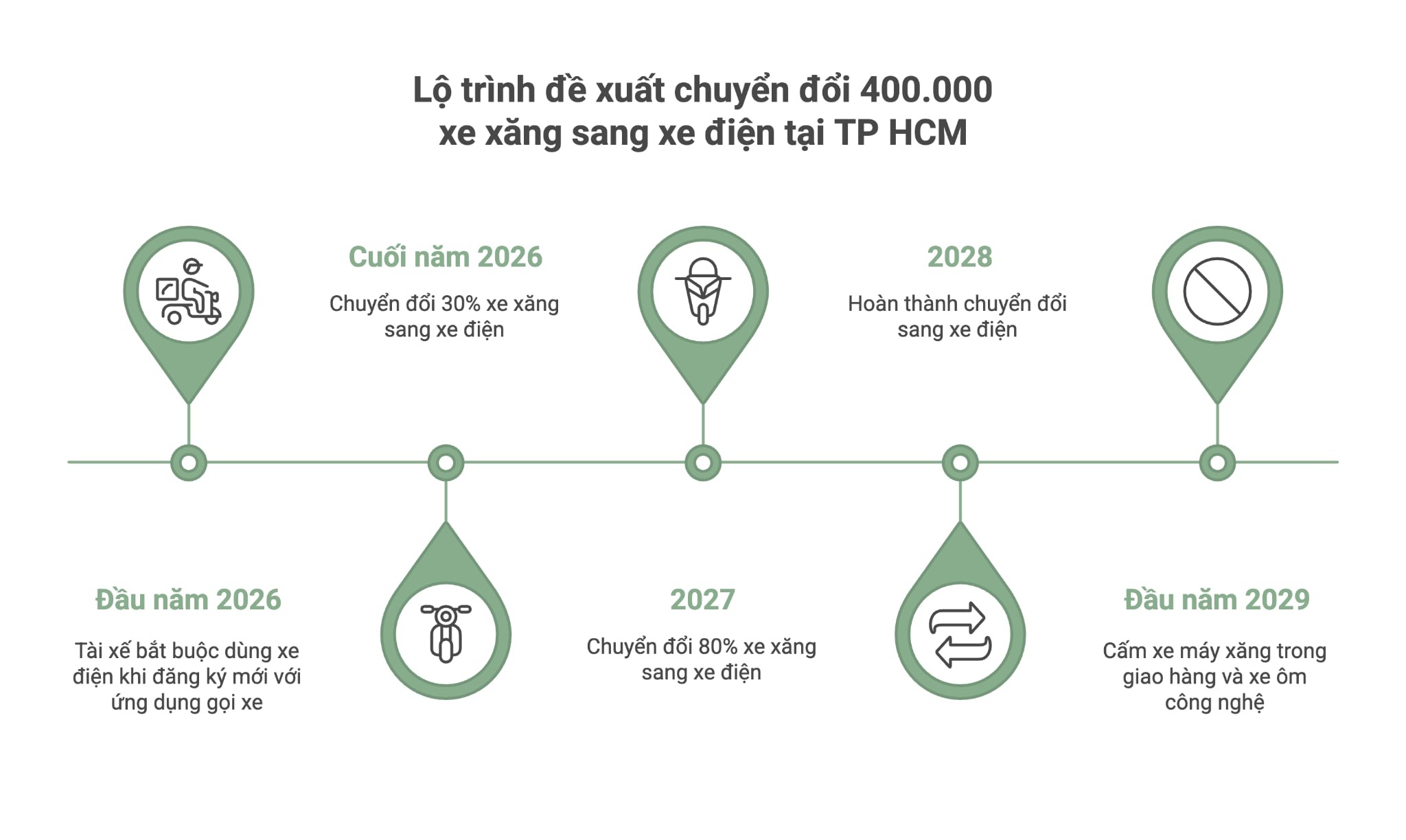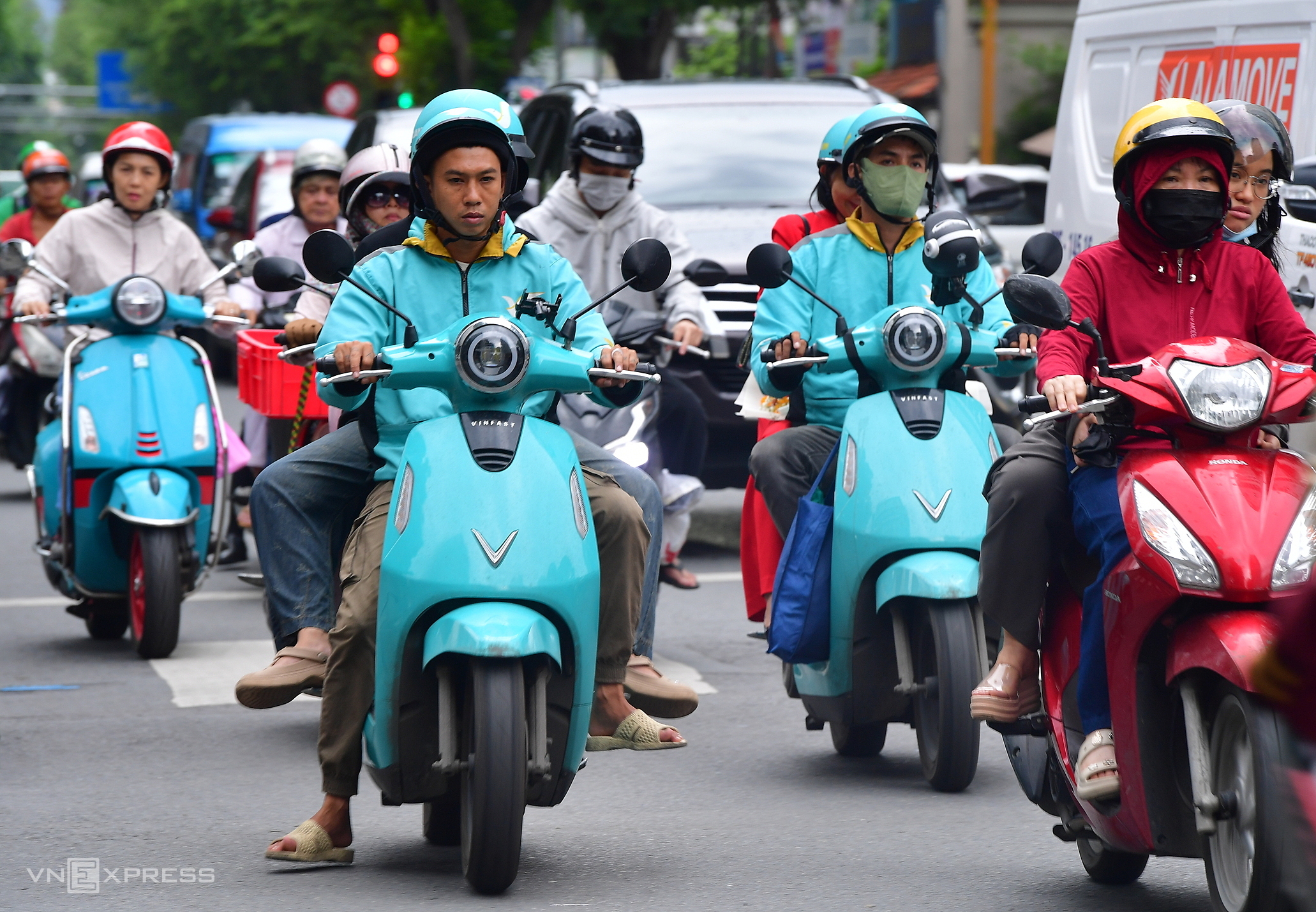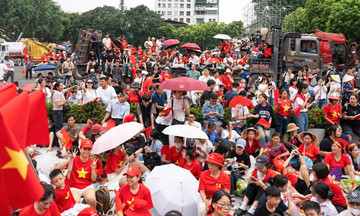The Center for Economic Application Consultancy (Ho Chi Minh City Institute for Development Studies - HIDS) has completed a draft project to convert 400,000 gas motorbikes to electric ones for ride-hailing and delivery drivers in the city to reduce pollution. VnExpress interviewed master Le Thanh Hai about the feasibility, roadmap, and obstacles when the city implements this plan.
 |
Master Le Thanh Hai, Director of the Center for Economic Application Consultancy, HIDS, interviewed by VnExpress on the afternoon of 17/7. Photo: Thanh Tung |
- Why did Ho Chi Minh City choose the target of 400,000 ride-hailing vehicles in three years?
- Three years is a reasonable time for drivers to pay installments for electric vehicles with their fuel cost savings. Surveys show that ride-hailing drivers travel 80-120 km/day with high fuel consumption due to heavy loads, traffic jams, and waiting time. While the daily cost of gas is 70,000-100,000 VND, electric vehicles only cost about 20,000 VND. Thanks to this, each month, drivers can save 1-2 million VND, enough to pay installments for an electric vehicle costing about 30 million VND within 24-30 months, without affecting their income.
Experience from Xanh SM shows that after just over two years, they have captured nearly 40% of the ride-hailing market share. Therefore, the goal of converting the rest in three years is considered feasible.
Besides economic factors, dividing the project into three phases with incentives following the "early conversion, more benefits" approach will motivate the market. If policies are synchronized, the rate of electric vehicles will increase rapidly, creating a ripple effect on consumers. They will feel that the conversion is inevitable, and when buying a new vehicle, they will also consider switching to electric.
The period from 2025-2028 is also a "golden" time when global battery costs are forecast to decrease by 10-12% each year. Therefore, the city taking action during this phase helps avoid increasing opportunity costs and prolonging the payback period for the charging/battery swapping ecosystem.
- What is the specific roadmap for the project?
- The proposed conversion support policies for drivers include VAT exemption, registration fee exemption when buying a new vehicle, and low-interest rates for vehicle purchases. Ho Chi Minh City will also provide an additional 2% interest rate support. This is considered the "carrot" in this program. Along with that is the accompanying "stick," which are the sanctions if they do not convert.
In the first year, the city aims to convert 30% of ride-hailing vehicles, equivalent to 120,000 vehicles. This phase will implement policies such as VAT exemption, registration fee exemption, and 2% interest rate support. At the same time, drivers will be prohibited from registering new gas vehicles on ride-hailing platforms.
The second year will accelerate with the target of reaching 80% (about 320,000 vehicles). This is the last important phase to fully enjoy the incentives. Ho Chi Minh City also plans to apply emission quotas, establish Green Delivery Zones, and restrict gas vehicles during peak hours.
The final year aims to complete 100% conversion. The incentive policies will end, and the city will focus on completing legal frameworks and controlling emissions. From 2029, gas vehicles will be completely banned in ride-hailing services.
 |
Proposed roadmap for converting 400,000 gas motorbikes to electric vehicles in Ho Chi Minh City. Graphics by AI |
- Why not set a higher target when Ho Chi Minh City has over 8.6 million motorbikes?
- The policy of controlling motorbike emissions has been set by the government since 2010, but many options, including banning personal gas vehicles, have not been successful due to the lack of alternative vehicles. Now, with the development of electric vehicles - a zero-emission transportation option - the conditions have changed. However, changing consumer habits requires a roadmap and appropriate time.
400,000 ride-hailing vehicles are considered a reasonable starting point. This group is easy to control and has high emissions, as they travel 80-120 km/day, 3-4 times more than personal vehicles. Converting one ride-hailing vehicle is equivalent to the effect of 3-4 personal vehicles.
In addition, this group quickly adopts technology and can spread positive awareness about electric vehicles to the community. With data from platforms like Grab, Be, and ShopeeFood, the city can easily monitor and support the conversion process.
The project also considers the impact on livelihoods. After paying installments, each driver can save about 600,000 VND per month. For the low-income group, the city will provide initial support for 10,000 vehicles while encouraging the model of collecting and exchanging old vehicles.
Converting 400,000 ride-hailing vehicles is the beginning of a bigger dream, which is over 8 million personal motorbikes.
- How will the project affect the environment, infrastructure, and livelihoods?
- This project is a strategic effort by Ho Chi Minh City to reduce emissions and pollution, while bringing clear economic benefits to ride-hailing drivers and promoting the development of green infrastructure. The project still has challenges, but we have identified, evaluated, and proposed solutions.
The project is expected to reduce 315,000 tons of CO2 and 2,000 tons of fine dust annually, contributing to the implementation of the Net Zero 2050 commitment. In addition, the project promotes the recycling of batteries and old vehicles. Electric vehicle businesses will coordinate with lithium-ion battery recycling units. Metal from old gas vehicles can be reused to produce electric vehicles.
 |
Ride-hailing drivers using electric vehicles on the streets of Ho Chi Minh City. Photo: Thanh Tung |
Regarding infrastructure, Ho Chi Minh City currently has about 600 public charging stations (VinFast) and 50 battery swapping stations (Selex), mainly in apartments and shopping malls. The power grid has a reserve of about 40%, but does not yet take into account the demand for vehicle charging.
Ho Chi Minh City aims to build 3,000 charging and battery swapping points by the end of 2028, prioritizing gas stations, parking lots, and parks. At the same time, it will coordinate with the electricity sector to upgrade the grid in areas at risk of overload, apply flexible electricity pricing, encourage off-peak charging, and develop solar-integrated charging.
Regarding people's livelihoods, drivers are not affected but rather benefit. After the installment period, they not only own the vehicle but can also improve their income by saving on fuel costs, after deducting battery wear and tear, estimated at about 600,000 VND per month.
For poor and near-poor households, Ho Chi Minh City is also preparing an initial support package for 10,000 vehicles. The cost of buying an electric vehicle may be higher for some drivers. However, this has also been taken into account; for example, drivers can resell gas vehicles to those who do not use ride-hailing services, switching from high-mileage to low-mileage groups, significantly reducing emissions.
Drivers can also participate in programs to collect and exchange gas vehicles for electric ones. The project commits that the preferential policies will apply to drivers from other provinces.
- What is the biggest obstacle in implementing the project? How will the city address it?
The main challenge is coordination from technology platforms. Regulations not allowing new gas vehicle registrations may affect the number of new drivers joining and business strategies.
The government will apply clear legal mechanisms, binding the responsibilities and benefits of stakeholders. At the same time, it will integrate electric vehicle booking features on apps to encourage users to switch.
The city will also strengthen communication and coordinate with technology companies like Grab, Be, and Shopee to spread the benefits of conversion and increase community support.
- What is the public's reaction when the project is announced?
According to an internal survey, about 70% support it, while 30% are still concerned about the impact on livelihoods and the handling of old gas vehicles. However, the project has considered support and recycling options to ensure a balance of benefits. Gas vehicles can be repurposed or exchanged reasonably, without causing waste.
The project has been developed since 2022 and is currently part of Ho Chi Minh City's emissions control and green transition strategy. The problem lies not in the solution, but in the determination to implement it and the consensus of the whole society.
Le Tuyet












